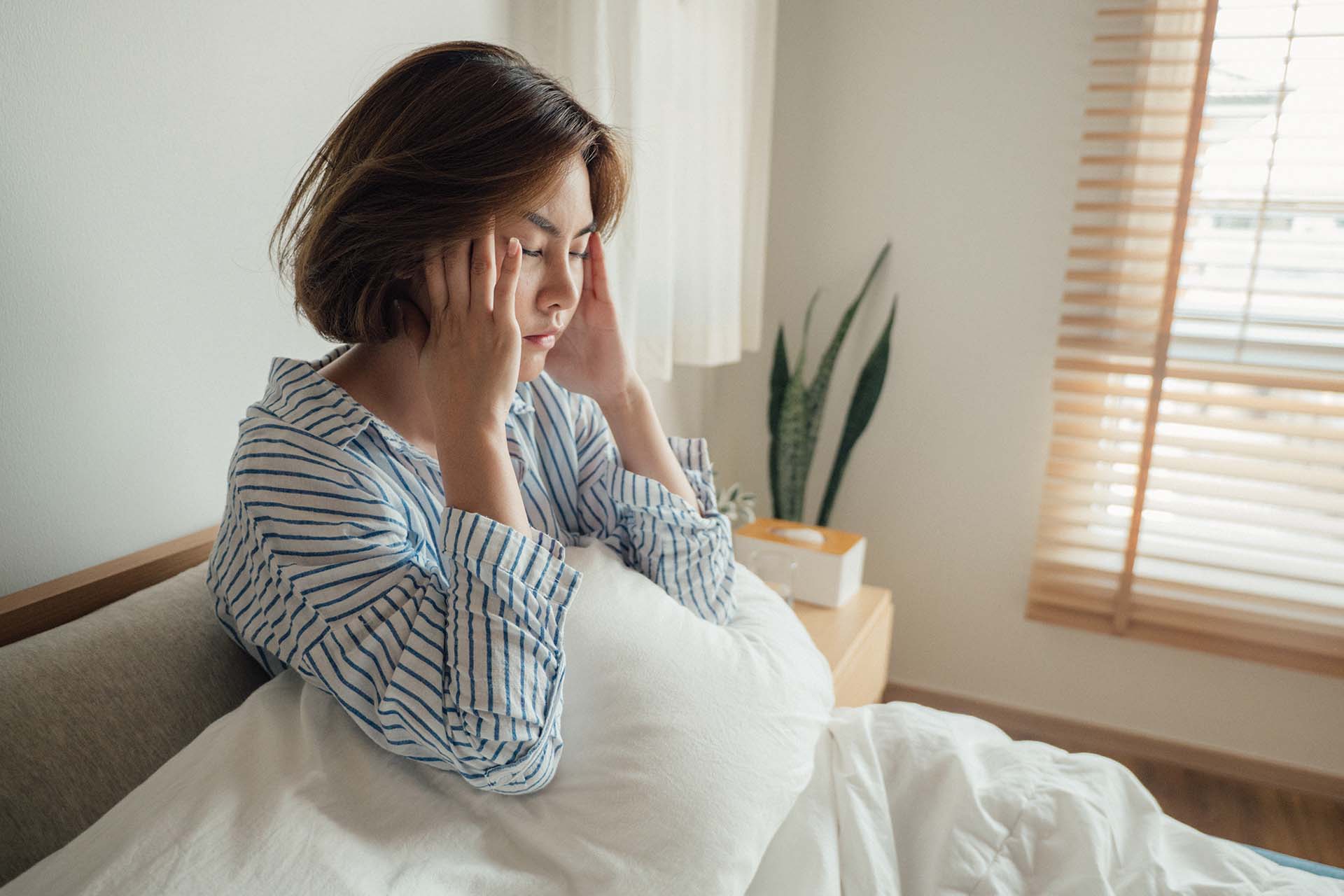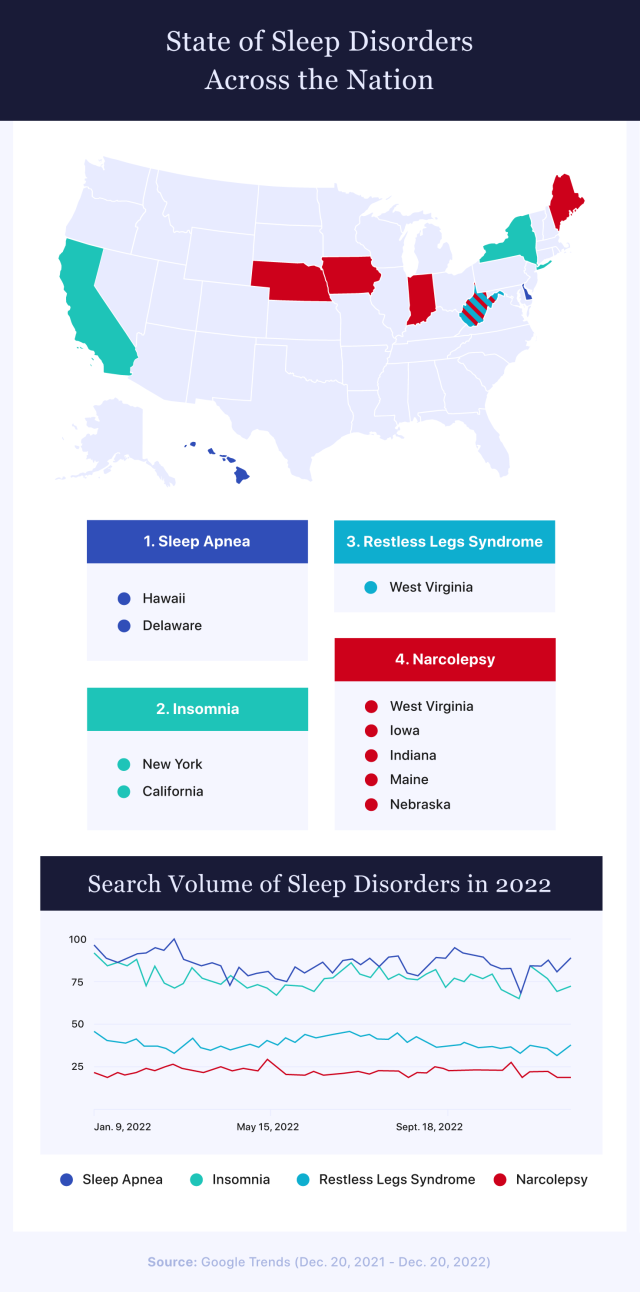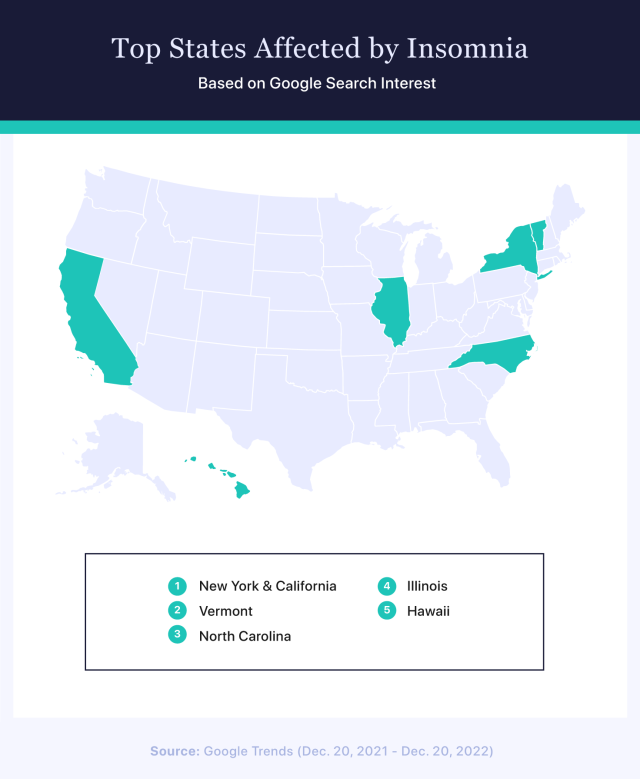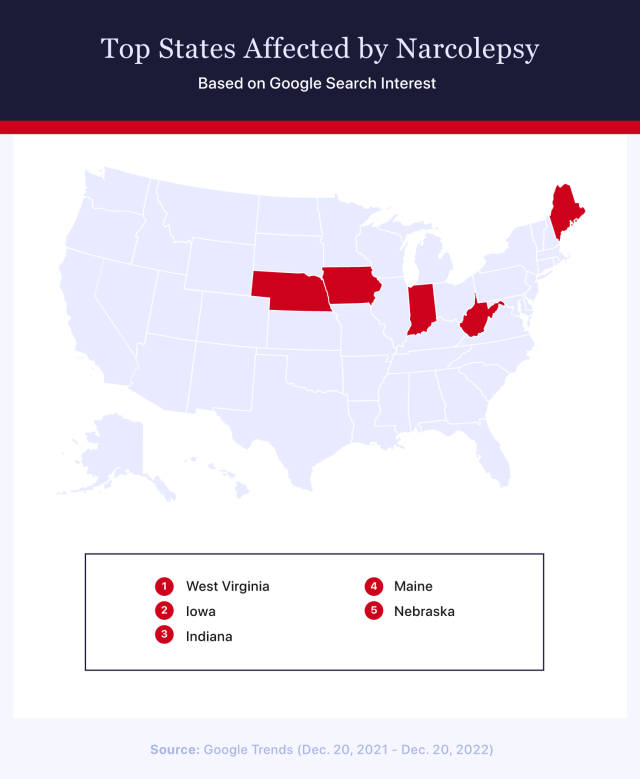Most Common Sleep Disorders by State
A healthy lifestyle starts with good sleep, but unfortunately, common sleep disorders can get in the way of that. Drugwatch examined the most common sleep disorders in the U.S., their causes and symptoms, and identified tips on how to get relief if you or a loved one are affected.

- The estimated number of sleep disorders in the U.S. increased 75% from 2004-2022.
- There are more than 80 different sleep disorders, but the most common are sleep apnea, insomnia, restless legs syndrome and narcolepsy.
- Sleep apnea was the most searched disorder for all U.S. states in 2022 except New York and California, where insomnia was the most searched sleep disorder.
- Hawaii and Delaware had the most interest in sleep apnea based on search results in 2022.
- The worst state for sleep disorders was West Virginia.
What Is a Sleep Disorder?
A sleep disorder is a condition that affects your sleep or makes it difficult for you to get a good night’s rest, which can lead to feeling sleepy during the day and other symptoms.
Most people occasionally struggle with sleep issues, but if it becomes a frequent occurrence for you to have trouble falling asleep, to feel exhausted even after a full night of sleep or to have diminished capacity for regular daytime activities, you may have a sleep disorder.
How Many People Have Sleep Disorders?
In the United States, an estimated 70 million people suffer from sleep disorders. This is a 75% increase from 2004, when nearly 40 million Americans experienced sleep disorders.
What Causes Sleep Disorders?
There are many causes that can contribute to sleep disorders. Even though the root causes of sleep disorders can vary, they all lead to the same problem: a disruption of your body’s normal sleep and wake cycles. Some causes may include:
- Physical: Conditions that cause chronic pain can interrupt your sleep.
- Environmental: Substances or activities like alcohol or prolonged screen time can hinder quality sleep.
- Mental: Mental health conditions such as anxiety or depression can affect your ability to fall asleep.
- Medical: Medical conditions like asthma can interrupt your sleep.
- Aging: Older adults may produce and secrete less melatonin.
- Medications: Some medications may interfere with sleep.
- Working the Night Shift: Your biological clock can be affected by this work schedule.
Symptoms of Sleep Disorders
- Difficulty staying awake when inactive (like reading or watching TV).
- Nodding off while driving.
- Trouble focusing or paying attention.
- Issues with performance at work or school.
- Being told by others that you look tired.
- Trouble remembering things.
- Slowed responses.
- Issues controlling your emotions.
- A need to take naps nearly every day.
Even if you suspect you have a sleep disorder, you should always consult a doctor before self-diagnosing.
Most Common Sleep Disorders by State
There are more than 80 different sleep disorders, but the most common include sleep apnea, insomnia, restless legs syndrome (RLS) and narcolepsy.
We examined the interest in these common sleep disorders using Google Trends between Dec. 20, 2021, and Dec. 20, 2022, to see which U.S. states searched for them most frequently. It’s important to keep in mind that the number of searches and the number of actual diagnoses for each disorder are not the same thing.
Based on the results, sleep apnea was the most searched sleep disorder across almost all U.S. states, with the exception of New York and California, where insomnia was the most frequently searched sleep disorder.

Sleep Apnea
Sleep apnea is a sleep disorder that happens when breathing is interrupted during the night. Those with untreated sleep apnea repeatedly stop breathing while they are asleep.
- Obstructive Sleep Apnea: This type of sleep apnea results from an obstruction of the airway, typically caused by the soft tissue in the back of the throat collapsing while you sleep. Snoring, restlessness during sleep, daytime fatigue, brain fog, dry mouth and gasping for air while sleeping are all potential symptoms.
- Central Sleep Apnea: This type of sleep apnea occurs when the brain fails to tell the body to breathe. People who have central sleep apnea may gasp for air, and they generally report many nighttime awakenings.

The use of a CPAP machine, also known as a continuous positive airway pressure device, is a widespread and effective treatment for obstructive sleep apnea. The machine has a mask that covers your mouth and nose and softly blows air into your airway while you sleep to help keep it open.
Insomnia
- Trouble falling asleep.
- Frequent nighttime awakenings and difficulty falling back to sleep.
- Waking up too early in the morning.
- Sleepless nights.
Most people will encounter short-term insomnia (also known as acute or adjustment insomnia) at some point in their lives, which can last anywhere from one night to as long as a week. Short-term insomnia affects 30% of U.S. adults and is typically caused by factors like jet lag or life stressors such as a job loss or death of a loved one.
Chronic insomnia, also known as long-term insomnia, is when people experience insomnia at least three nights a week for a month or longer. This condition is estimated to affect up to 10% of adults in the United States. Chronic stress, certain medications like Adderall and nighttime pain or discomfort are just a few of the possible causes of this kind of insomnia.

Restless Legs Syndrome (RLS)
Restless legs syndrome is a sleep disorder that results in an acute, frequently uncontrollable urge to move the legs. Resting, such as lying down in bed, or sitting for a long time, like while driving or in a movie theater, can trigger this experience.
RLS frequently occurs in the evening, making it challenging to get to sleep and stay asleep. Those with RLS frequently want to move around and shake their legs to ease the uncomfortable feeling.

Narcolepsy
Sleep and wakefulness control is impacted by narcolepsy, a neurological sleep regulation disorder. Those affected by narcolepsy frequently have uncontrollable episodes of falling asleep and excessive daytime sleepiness.
Any form of activity at any time of the day may trigger these unexpected sleep attacks. Laughter or other emotions might also cause unexpected muscle weakness in some people who have narcolepsy.

Self-Help for Sleep Disorders
If you’re experiencing symptoms of a sleep disorder, such as having a hard time falling asleep, staying asleep or staying awake during the day, there are a few things you can try at home to help you get a good night’s sleep.
Establish a Relaxing Bedtime Routine: Do things that help you relax, such as meditation, journaling, taking a bath or listening to soothing music before bed.
Wake Up at the Same Time Every Morning: Make sure you wake up at the same time each morning, even on weekends or during vacations, to help establish your wake cycle.
Turn Down the Thermostat: Doctors recommend keeping the thermostat set between 60 and 67 degrees Fahrenheit for the most comfortable sleep.
Block Out Light and Noise: Use a sleep mask or blackout curtains to limit light, and use earplugs or a white noise machine if noise tends to keep you awake.
Use Your Bed for Sleep Only: To establish your bed as a place of rest only, avoid eating, watching television, playing video games or working on your computer in bed.
Exercise Regularly:Recent research indicates that exercise decreases sleep complaints and insomnia in patients, but make sure not to exercise within four hours of your bedtime so your body has time to cool down.
Avoid Caffeine: Caffeine can be a lifesaver for groggy mornings, but try to avoid it as an afternoon pick-me-up. Avoid caffeine for at least six hours before bedtime.
Eat Earlier Dinners: Don’t eat heavy meals within four hours of bedtime. If you get hungry, bedtime snacks such as walnuts, crackers or cherries may help you fall asleep easier.
Stop Bedtime Scrolling: The National Sleep Foundation recommends you stop using electronic devices, like your smartphone, at least 30 minutes before bedtime.
Have a Positive Mindset: Try to stop staring at your clock or thinking about the consequences of not falling asleep quickly. If you feel restless, try journaling or making a to-do list to tackle the next day.
Avoid Alcohol and Nicotine: Don’t drink alcohol or use nicotine devices such as cigarettes or e-cigarettes at night or at least four hours before bedtime.
Limit Naps: Don’t nap more than 30 minutes and avoid napping after 3 p.m.
As you incorporate these healthy habits into your lifestyle, it’s important to note that these tips may not cure more serious sleep disorders such as sleep apnea and chronic insomnia.
It’s difficult to self-diagnose a sleep disorder, so if you suspect you may have one, it’s best to consult a doctor. Make sure to keep track of your symptoms and discuss them with your doctor so you can begin an effective treatment that’s right for you.
Methodology
By examining the percentage of searches in Google Trends for each term in a certain area from Dec. 20, 2021, to Dec. 20, 2022, we were able to identify the top states for common sleep disorders.
Calling this number connects you with a Drugwatch representative. We will direct you to one of our trusted legal partners for a free case review.
Drugwatch's trusted legal partners support the organization's mission to keep people safe from dangerous drugs and medical devices. For more information, visit our partners page.

